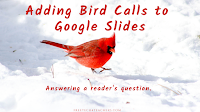Click here to read this mailing online.
Here are the latest updates for nurhasaan10@gmail.com "Free Technology for Teachers" - 4 new articles
Top Tools and Activities for Collaborative Learning in 2022This blog post was sponsored by Lumio, but it features a bunch of other great tools as well. At this point in the school year and our second school year in a pandemic, we’ve all become familiar with the nuts and bolts of Zoom, Microsoft Teams, Google Meet, or whatever other platform your school uses for live, online instruction. The challenge is no longer how to use those tools, it's how to use them in conjunction with other collaborative learning tools so that our students don’t suffer from device-o-lation (a term I recently learned from Kacie Germadnik). To that end, here are some of my favorite tools that can be used for collaborative learning online, in-person, or both. Social Studies A classic social studies class assignment is to have students create timelines. There are two tools that recommend more than any others for students to use to collaboratively create timelines. Those are Timeline JS and Canva. Canva is a little more aesthetically pleasing than Timeline JS, but Timeline JS offers a bit more flexibility in terms of content inclusion. Creating a timeline with Timeline JS is done in a Google Sheets template that students can collaborate on. Canva offers timeline templates that students can share. An overview of how to use Timeline JS can be seen here. A demo of making timelines in Canva can be watched here. Creating and or labeling maps is another classic social studies assignment that once was done on paper and can now be done in a collaborative digital environment. One way to make this a collaborative activity is to use Google Drawings as I demonstrated before the start of the last school year. Another option is to use Lumio to import an image of a map and then have students work together to label it. Here’s a good example of using Lumio for that purpose. By the way, if you like that example you can save a copy of it and use it with your own students. Here’s a little instruction on how to make copies of Lumio activities. Language Arts I’ve told this story dozens of times over the years and I’ll tell it again. I got my first teaching job as a mid-year replacement for a ninth grade language arts class. In the classroom that I inherited I found a stack of comic books with a note that read, “these might help with your reluctant readers.” They sure did! Since then I’ve used comics as reading material and used comic creation as a writing activity in language arts and in social studies classes. There are many tools for creating comics individually, but few that support collaborative creation of comics. A couple of options for collaborative comic creation are Google Slides as shown here, Canva as demonstrated here, and Lumio as found in these templates. And if you want your students to map their stories before they begin the comic creation process, you can have them use one of Lumio’s graphic organizer templates. Math When I think of math instructional tools I think of two things, Desmos and virtual manipulatives. Desmos, for those who aren’t familiar with it, is a free online graphic calculator. But it’s much more than that. In addition to the calculator tools, Desmos provides activities to distribute to students and tools for students to share their thinking and work with you and each other. Additionally, Desmos is now integrated into Lumio where you can create activities for students to complete individually or collaboratively. Here’s a selection of Desmos-integrated activities in Lumio. In the last two years I’ve answered more questions about creating virtual manipulatives for math than I did in all of the first twelve years of writing this blog. In most cases I suggested using Google’s Jamboard to create virtual manipulatives because you can let students use them individually or collaboratively depending upon the sharing settings that you choose. This fall, I started referring some people to Lumio because it provides fifteen virtual manipulatives templates that are perfect for elementary school math lessons. And much like Jamboard, the Lumio virtual manipulatives can be used individually or collaboratively depending on the settings that you choose. Science If you teach a middle school or high school science class, you should be familiar with PhET simulations produced by University of Colorado, Boulder. PhET offers more than 150 simulations for teaching concepts in physics, chemistry, biology, and earth science. Many of these simulations can be used as stand-alone activities or be used as part of a larger activity in which students make and share observations. Take a look through these PhET activities to find one that meets your needs. PhET is also integrated into Lumio where you can use the simulations to create collaborative learning experiences for your students. Here’s a selection of PhET-integrated learning activities available in Lumio. Bottom Line The value of any collaborative learning tool comes down to how it’s used by you and your students. The value of collaboration is learning from each other as well as from the teacher. When using collaborative learning tools remember to give students time to “wander” a bit as they generate and exchange ideas. It’s during that time that many students will begin to feel connected to their classmates and a little less device-o-lated. TeacherMade Adds New Feedback Types and Makes Pro Features Free!TeacherMade is a platform for creating online, interactive assignments for your students. I first covered it in the fall of 2020 and since then it has rapidly grown in popularity. One reason for that growth is that TeacherMade lets you take your existing favorite documents and turn them into automatically graded online assignments. You can even use it to add audio to your document-based assignments. As any good edtech tool should, TeacherMade has continuously made improvements and added features since its inception. The latest round of updates to TeacherMade include some great enhancements to the way that you can provide feedback to your students and the ways that students can complete assignments. Updates for Teachers! TeacherMade now offers you the ability to record individualized audio feedback on your students’ assignment submissions. You can also now draw and highlight on your students’ submitted assignments. Doing that should make it a lot easier for students to understand exactly what you’re giving them feedback on. That could be particularly handy when giving feedback on an assignment that has large blocks of text in it. Finally, you can now reward your students with fun stickers and emojis that you add to their submitted assignments. Updates for Students! Updates to the feedback tools aren't the only things new in TeacherMade in January. Right after the start of the year TeacherMade introduced new options for assignment creation and assignment completion. Those new options include the ability to let students add math expressions to any assignment even those that don’t specifically list a math problem for students. That option could be useful for STEM assignments that contain open-ended questions or prompts. One of the other early-January updates to the student experience in TeacherMade is an option to enable students to use special characters when completing assignments. This new option supports diacritical marks and special characters found in French, German, Italian, Spanish, and Portuguese. Updates and Resources for Everyone! TeacherMade is a company that I’ve seen listen to teachers’ feedback and implement as fast as possible. One of the places they get that feedback is in the TeacherMade Community message board. It’s there that you can connect and share ideas with other teachers who are using TeacherMade. It’s also there that you’ll find activities developed by TeacherMade staff and other teachers that you can copy, modify, and use in your classroom. For example, take a look at this collection of activities for teaching about Martin Luther King, Jr. and this collection of shared holiday activities. The biggest TeacherMade news by far is that TeacherMade Pro is going to be free for all teachers for the next 60 days! This will give all teachers access to all of TeacherMade’s features including syncing Google Classroom rosters with your TeacherMade account. Syncing the two accounts makes it very easy to post TeacherMade activities as assignments in Google Classroom. To access TeacherMade Pro you don’t need to do anything more than sign into your existing, free TeacherMade account and follow the prompts for accessing the pro version. If you don’t already have a free TeacherMade account, now is the time to get one. A Cool Combination With TeacherMade Canva and TeacherMade is a great combination for folks who would like to make great-looking activities but don’t have either the eye for design or the time to make them. You can utilize any of the more than 2,000 worksheet templates offered by Canva and then import them into your TeacherMade account to create interactive, online activities. Watch this video to learn how easy that process is. Disclosure: TeacherMade is curently an advertiser on FreeTech4Teachers.com Adding Bird Calls to Google Slides - Answering a Reader's QuestionYesterday I answered an email from a reader who was looking for a little help with her students' Google Slides projects. The students were creating slideshows about birds and wanted to add some audio to the slides. Using Mote wasn't an option for her students. So my suggestion was to find or record audio outside of Google Slides then upload it to Google Drive before inserting it into the slides. I then created the following video to further explain my solution. In this new video I demonstrate two options for adding audio to Google Slides. The first option was to use an audio file that I found on Archive.org. The second option was to use audio that I recorded using Vocaroo. Two Ed Tech Guys Take Questions - Live at 4pm ET TomorrowTomorrow at 4pm ET/ 1pm PT Rushton Hurley from Next Vista for Learning and I are hosting the next episode of the second season of Two Ed Tech Guys Take Questions and Share Cool Stuff! We'd love to have you join us! You can register for the session right here. In every episode we answer questions from readers and viewers like you. We also share some cool and interesting things that we've found around the Web. Rushton tends to share cool videos and pictures while I tend to share cool tech tools. And we both try our best to give helpful answers to your questions about all things educational technology. Please join us! And feel free to email me in advance with your questions or send them in live during the webinar. Recordings and resources from our previous episodes are available on this Next Vista for Learning page. More Recent Articles |
Email subscriptions powered by FeedBlitz, LLC • 1800 Camden Road, Suite 107-258 • Charlotte, NC 28203, USA
« Prev Post
Next Post »









ConversionConversion EmoticonEmoticon